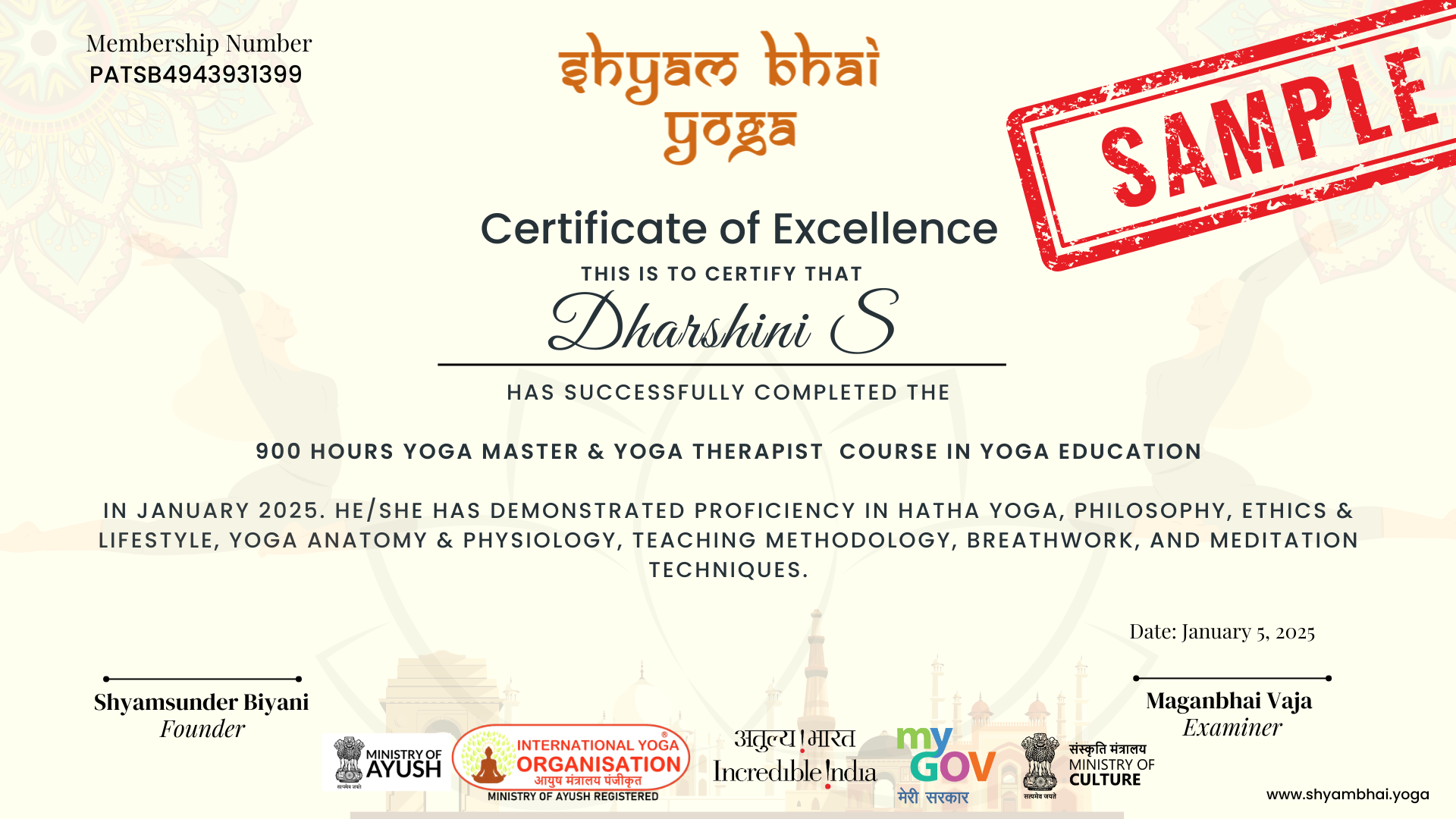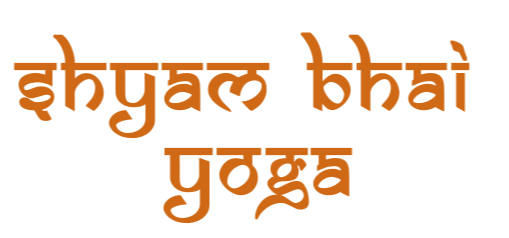900 Hours Online Yoga Teacher Training Course
Ready to elevate your practice to the highest level? Shyambhai’s 900-Hour Online Yoga Teacher Training is designed for those committed to a deep and comprehensive understanding of yoga. This program provides an immersive experience, allowing you to master advanced techniques, therapeutic applications, and in-depth philosophical insights from the convenience of your own home. Ideal for dedicated practitioners, future yoga therapists, and advanced instructors, this training offers a profound blend of theory, practical skills, and traditional wisdom. With a fee of Rs. 64,999, this investment not only grants you a certification but initiates a transformative journey that refines your personal growth and professional mastery. Join us and become a part of an enriching yoga legacy!
Why Choose Shyambhai Yoga Certification?
🌟 Daily live sessions
🌟 A complete learning experience from home
🌟 Flexible schedule to fit your routine
🌟 Small classes for more personal support
🌟 Official certification from YCB (Yoga Certification Board)
🌟 Lessons from expert teachers

900 Hours Yoga Teacher Training Course (YTT) curriculum
Join our 900-Hour Yoga Teacher Training program for a thorough and expertly designed immersion into yoga. Created by master practitioners, this curriculum builds a strong foundation in both practical techniques and the philosophy of yoga. Whether your goal is to teach or to enrich your own practice, this program provides the essential tools and insights for a transformative yoga journey.
The syllabus includes:
Unit 1: Foundation of Yoga
1.1 Etymology and Definitions of Yoga (Patanjala Yoga Sutra, Bhagwad Gita, Kathopanishad)
1.2 Brief Introduction to origin, history and development of Yoga (Pre-Vedic period to contemporary times)
1.3 Yoga in Principle Upanishads
1.4 Yoga tradition in Jainism: Syadvada (theory of seven fold predictions); Concept of Kayotsarga/Preksha meditation)
1.5 Yoga Tradition in Buddhism: concept of Aryasatyas (four noble truths)
1.6 Salient features and branches of Bharatiya Darshana (Astika and Nastika Darshana)
1.7 General introduction to Shad Darshana with special emphasis on Samkhya, Yoga and Vedanta Darshana
1.8 Brief survey of Yoga in Modern and Contemporary Times (Shri Ramakrishna, Shri Aurobindo, Maharishi Raman, Swami Vivekananda, Swami Dayananda Saraswati, Swami Shivananda, Paramhansa Madhavadas ji, Yogacharya Shri T. Krishnamacharya)
1.9 Guiding principles to be followed by the practioner
1.10 Brief Introduction to Schools of Yoga; Jnana, Bhakti, Karma, Raja & Hatha
1.11 Principles and Practices of Jnana Yoga
1.12 Principles and Practices of Bhakti Yoga
1.13 Principles and Practices of Karma Yoga
1.14 Concept and Principles of Sukshma Vyayama, Sthula Vyayama, Surya Namaskars and their significance in Yoga Sadhana
1.15 Concept and Principles of Shatkarma: Meaning, Types, Principles and their significance in Yoga Sadhana
1.16 Concept and Principles of Yogasana: Meaning, definition, types and their significance in Yoga Sadhana
1.17 Concept and Principles of Pranayama: Meaning, definition, types and their significance in Yoga Sadhana
1.18 Introduction to Bandha & Mudra and their health benefits
1.19 Introduction to Yogic relaxation techniques with special reference to Yoga Nidra
1.20 Introduction to Dhyana and its role in health and well being
Unit 2: Introduction to Yoga Texts
2.1 Introduction to Prasthanatrayee, Purushartha Chatushtaya and goal of human life
2.2 Yoga in Kathopanishad, Prashanopanishad, Taittiriyopnishad with special emphasis on Panchakosha Vivek and Ananda Mimamsa
2.3 Concept of Sthitaprajna (stages and characteristics) in Bhagavad Gita
2.4 Significance of Bhagavad Gita as a synthesis of Yoga
2.5 Concept of healthy living in Bhagavad Gita (Ahara, Vihara, Achara, Vichara)
2.6 Introduction and highlights of Yoga Vasishtha, Definitions of Yoga and their relevance in Yoga Vasishtha
2.7 Study of Patanjal Yoga Sutra including selected sutras from following chapters (I- 1 to 12, II 1 to 2, 46 to 55, III- 1 to 6)
2.8 Concept of Chitta, Chitta Bhumi, Chitta Vritti, Chitta Vikshepa, Chittaprasadanam, Klesha and Vivek-Khyati and their relationship with wellness
2.9 Concept of Ishwara and its relevance in Yogasadhana, qualities of Ishwara, Ishwarapranidhana
2.10 Concept of Kriya Yoga of Patanjali and its importance for healthy living
2.11 Bahiranga Yoga of Maharisi Patanjali (Yama, Niyama, Asana, Pranayama, Pratyahara)
2.12 Antaranga Yoga of Maharishi Patanjali (Dharana, Dhyana, Samadhi)
2.13 Concept of mental well-being according to Patanjala Yoga
2.14 Hatha Yoga: Its origin, history and development. Hatha Yoga: its meaning, and definition, aim, objectives and misconception about Hatha Yoga
2.15 Sadhaka Tattva and Badhaka Tattva principles to be followed by Hatha Yoga practitioner
2.16 Concept of Matha, Mitahara, Pathya & Apthaya, Types of Aspirants
2.17 Hatha Yoga practices according to different Hatha Yogic Texts (Hatha Pradipika, Gheranda Samhita and Hatharatnavali)
2.18 Concept of Shwasa-Prashwasa, Vayu, Prana, Upa-Prana, Shat Chakra etc.
2.19 Knowledge of Hatha Yoga practices for wellness (Shatkarma, Asanas, Pranayama, Mudra, Nadaanusandhana)
2.20 Relevance and importance of Hatha Yoga practices in health and well being
UNIT 3: Yoga And Health
A. Introduction to Human Body – Anatomy and Physiology
3.1 Introduction to Human body
3.2 Basic structure and functions of Musculoskeletal system, Respiratory system, Cardio vascular system, Nervous system, Digestive system and Endocrine system
3.3 Homeostasis: its mechanism to maintain internal environment of the body
3.4 Introduction to sensory organs (Eyes, Nose, Ears, Tongue and Skin)
3.5 Impact of Yogic practices on different systems of the human body: Benefits of Shatkarma, Yogasana, Pranayama and Bandha on Respiratory, Circulatory, Musculoskeletal system
B. Introduction to Psychology
3.6 Introduction to psychology, concept of human psyche, stages of consciousness, cognitive process: Its meaning and nature
3.7 Definition and nature of Behavior, kinds of Behavior Motivation
3.8 Emotions: definition, nature and physiological changes during Emotion
3.9 Mental Health: Yogic view of Mental Health and Mental Illness
3.10 Role of Yoga in Mental Health. Importance of psychosocial environment for health and wellness
C. Yoga For Health And Wellness
3.11 Yogic concept of health, wellness and illness
3.12 Importance of psycho-social environment for health and wellness
3.13 Role of Yoga in various dimensions (physical, mental, social and spiritual) of health
3.14 Importance of following Dinacharya and Ritucharya for well being
3.15 Role of Ahara, Nidra and Brahmacharya in wellness
D. Yoga For Disease Prevention And Health Promotion
3.16 Meaning and definition of Health and Disease, Concept of Adhi and Vyadhi, Yoga as a preventive Health care- Heyam dukham anagatam
3.17 Potential causes of ill-health: Tapatrayas and Kleshas, Mental and Emotional ill Health: Anatrayas
3.18 Shuddhi Prakriyas in Yoga and their role in preventive and curative Health
3.19 Knowledge of Trigunas, Pancha-Kosha, Pancha-Prana and Shatkchakra and their role in Health and Disease
3.20 Yogic concept of Holistic Health and its importance in the management of Diseases
UNIT 4: Applied Yoga
A. Yoga And Education
4.1 Education: Its meaning, definition and goal, role and importance of education in Human Excellence
4.2 Yoga in Education: Salient features of Yoga Education, Factors of Yoga Education: Teacher, Student and Teaching, Guru-Shishya-Parampara and its importance in Yoga Education
4.3 Value Education: Its Meaning and Definition, Types of values, value-oriented Education in Personality Development
4.4 Contribution of Yoga towards Development of Values, Spiritual Growth
4.5 Salient features of Ideal Yoga Teacher, Role of Yoga Teacher in Value-oriented Education, Role of Yoga in development of healthy society
B. Yoga For Personality Development
4.6 Personality: Meaning and types of personality
4.7 Determinants of Personality with reference to psycho-social environment
4.8 Knowledge of various facets and stages of development of personality
4.9 Personality Development; Role of spirituality and positive attitude in personality development
4.10 Role of Yogic practices (Asana, Pranayama, Shatkarma, Bandha, Mudra etc.) in the Personality Development
C. Yogic management of stress and its Consequences
4.11 Definition, nature and types of stress
4.12 Symptoms and consequences of stress on human mind
4.13 Yogic perspective of stress. Yogic principles for the management of stress and its consequences
4.14 Concepts and techniques of Stress management in Ashtanga Yoga of Patanjala Yogasutra and Bhagawad Gita
4.15 Specific practices for stress management: Yogasana, Breath Awareness, Shavasana, Yoganidra, Pranayama and Meditation
D. Yoga for prevention and management of Life Style Disorders
4.16 Concept of Yogic life style and its relevance
4.17 General knowledge about life style related disorders: Acidity, Constipation, Irritable bowel syndrome(IBS), Bronchial Asthma, Sinusitis, Hypertension, Neck pain, Low Backache, Osteo-arthritis etc.
4.18 Role of Yoga in prevention and management of common disorder: Acidity, Constipation, Irritable bowel syndrome (IBS), Bronchial Asthma, Sinusitis, Hypertension, Neck pain, Low Backache, Osteo-arthritis
4.19 Role of Yoga in prevention and management of non-communicable disorders
4.20 Yoga as an integrative medication
Unit 5: Yoga Practicals
5.1 Prayer
– Concept and Recitation of Pranava
– Concept and Recitation of Hymns
– Selected universal prayers, invocations and Nishpatti Bhava
5.2 Yogic Shat Karma
– Neti: Sutra Neti and Jala Neti
– Dhauti: Vamana Dhauti (Kunjal)
– Kapalbhati (Vatakrama)
5.3 Yogic Sukshma Vyayama and Sthula Vyayama
Yogic Sukshma Vyayama (Microcirculation Practices)
– Neck Movement
– Griva Shakti Vikasaka (I,II,III,IV)
– Shoulder Movement
– Bhuja Valli Shakti Vikasaka
– Purna Bhuja Shakti Vikasaka
– Trunk Movement
– Kati Shakti Vikasaka (I, II, III, IV, V)
– Knee Movement
– Jangha Shakti Vikasaka (II-A&B)
– Janu Shakti Vikasaka
– Ankle movement
– Pada-mula shakti Vikasaka – A&B
– Gulpha-pada-pristha-pada-tala shakti Vikasaka
Yogic Sthula Vyayama (Macrocirculation Practices)
– Sarvanga Pushti
– Hrid Gati (Engine run)
5.4 Yogic Surya Namaskara with Mantra
5.5 Yogasana
– Tadasana, Hastottanasana, Vrikshasana
– Ardha Chakrasana, Padahastasana
– Trikonasana, Parshva Konasana, Katichakrasana
– Dandasana, Bhadrasana, Padmasana, Vajarasana
– Yogamudrasana, Parvatasana
– Mandukasana, Ushtrasana, Shashankasana, Utthana Mandukasana
– Paschimottanasana, Purvottanasana
– Vakrasana, Ardha Matsyendrasana, Gomukhasana
– Makarasana, Bhujangasana, Salabhasana, Dhanurasana
– Pavanamuktasana and its variations
– Uttanapadasana, Ardha Halasana, Setubandhasana, Saral-matsyasana
– Halasana, Chakrasana
– Sirshasana
– Shavasana
5.6 Preparatory Breathing Practices
– Sectional Breathing (Abdominal, Thoracic and Clavicular Breathing)
– Yogic Deep Breathing
– Anuloma Viloma/Nadi Shodhana
5.7 Pranayama
– Concept of Puraka, Rechaka and Kumbhaka
– Ujjayee Pranayama (Without Kumbhaka)
– Sheetali Pranayama (Without Kumbhaka)
– Sitkari Pranayama (Without Kumbhaka)
– Bhramari Pranayama (Without Kumbhaka)
5.8 Concept and Demonstration of Bandha and Mudra
- a) Bandha
– Jalandhara Bandha
– Uddiyana Bandha
– Mula Bandha
- b) Mudra
– Yoga Mudra
– Maha Mudra
– Vipareetakarani Mudra
5.9 Practices leading to Dhyana Sadhana
– Body awareness and Breath awareness
– Yoga Nidra
– Antarmauna
– Recitation of Pranava and Sohama
– Recitation of Hymns
– Practice of Dhyana
5.10 Methods of Teaching & Evaluation
– Teaching methods with special reference to Yoga
– Factors influencing Yoga teaching
– Need of teaching practice and its use in Yogic practice
– Teaching Aids: Meaning and Need, Role of Language, Voice, Fluency, Clarity and Body language in an ideal presentation
– Methods of teaching Yoga to an individual, small group and large group
– Use of audio-visual aids, ICT, multimedia and online resources
– Lecture cum demonstration in Yoga: Its meaning, importance and method of its Presentation
– Lesson plan: Its meaning and need
– Preparation of lesson plan in Yoga, Preparation of lesson plan for an individual and for a group
– Presentation of lessons in specific Yogic practices: Kriya, Asana, Pranayama, and Dhyana
– Assessment of a Yoga class (detection and correction of mistakes)
– Measurement, assessment and evaluation: concepts, principles and applications
– Examination reforms and designing formative and summative evaluation
– Programme evaluation: Yoga class/workshops/camps, yoga teaching, and yoga teacher
– Assessment of yoga centres and institutes- criteria, processes, instruments, results
Eligibility Requirements
✅ This advanced 900-Hour Online Yoga Teacher Training is open to practitioners who have completed a 200-hour yoga teacher training certification or 500-hour yoga teacher training certification and have at least two years of consistent yoga practice. Participants must be 18 years or older. Upon successful completion, you will earn an advanced certification recognized by the Yoga Certification Board (YCB), qualifying you to lead specialized yoga programs worldwide.
Learning Format
✅ The 900-Hour Online Yoga Teacher Training will be taught in both Hindi and English, ensuring accessibility for a wide range of participants. All course materials will be provided digitally, so you have easy access to everything you need for your studies. Live classes will take place on Zoom, allowing for real-time interaction and personalized guidance from experienced instructors. Upon enrollment, you will receive the meeting ID and password via WhatsApp, which should be kept private. To support your learning, we will conduct review sessions every two weeks to go over key topics, and if you miss any classes, they will be covered again during these review sessions.
Certification and Teaching Eligibility
✅Upon completing your 900-hour online yoga teacher training, you will receive an official certificate recognized by the Yoga Certification Board (YCB). This prestigious certification qualifies you to teach yoga worldwide, opening doors for you to pursue yoga as a professional career.
Career Opportunities
✅Graduates of this 900-hour online yoga teacher training program can embark on diverse career paths as professional yoga instructors. With this advanced qualification, you’ll be equipped to teach in a variety of settings, including private sessions, corporate environments, yoga studios, gyms, wellness retreats, hotels, and even healthcare facilities.
Key Benefits of Our 900 Hours Yoga Teacher Training Course (YTT)
Advanced Certification
Upon successful completion, you’ll receive an advanced certification recognized by the Yoga Certification Board (YCB), opening up global teaching opportunities.
Lifetime Career Support
Our team of seasoned yoga teachers are not only experts in their field, but also deeply passionate about sharing their knowledge and guiding you on your transformative journey.
Global Networking Opportunities
Connect with a diverse community of like-minded yoga practitioners from around the world, offering you valuable networking and collaboration opportunities.
Customizable Learning Path
The program allows flexibility for different interests, whether you’re focused on teaching, therapy, or deepening your own knowledge, ensuring a personalized learning experience.
Yoga Therapy Integration
Learn to apply yoga principles in therapeutic settings, helping you become a skilled yoga therapist and work with a variety of physical and mental health challenges.
Confidence in Teaching
Build the confidence to lead yoga classes of all levels, from beginners to advanced students, with a solid foundation in teaching methodology, anatomy, and alignment.
What to Expect from a 900-hour Yoga Teacher Training Course?
If you’re ready to take your yoga journey to the highest level, our 900-Hour Online Yoga Teacher Training with Shyambhai Yoga offers an unparalleled opportunity for deep transformation. This extensive program is designed to elevate both your personal practice and teaching abilities, providing a profound understanding of advanced yoga techniques, philosophies, and therapeutic applications.
Over the course of 900 hours, you will explore a wide range of topics, from advanced asanas (postures) and pranayama (breathing techniques) to meditation practices and the deeper aspects of yoga philosophy. Our experienced instructors will guide you through a rich and immersive learning experience, covering everything from anatomy and alignment to specialized techniques for working with various body types and unique needs.
This program goes well beyond foundational yoga knowledge, integrating the wisdom of Ayurveda, yoga therapy, and other holistic practices into your learning. You will master the art of sequencing creative and effective yoga classes while gaining advanced skills in student communication, engagement, and personal development. Whether you aspire to teach therapeutic yoga, deepen your understanding of yoga’s roots, or work with specific populations, this training will equip you to serve your students with greater skill and compassion.
By the end of this 900-hour course, you will emerge as a confident, skilled, and well-rounded yoga teacher, ready to lead students through complex practices while continuing your own journey of self-discovery. At Shyambhai Yoga, we offer a nurturing and supportive environment where you can flourish both as a practitioner and educator.
If you are ready to immerse yourself in the depth and richness of yoga and become a globally recognized teacher, we welcome you to join our vibrant community. Prepare for a truly transformative experience with Shyambhai Yoga, where your personal and professional growth will soar.
Sample Certification

If you want to become a true yoga master, this is THE program.
They cover everything from ancient texts to modern scientific research. The therapeutic yoga alone are worth the entire course fee. Learned how to work with doctors and create rehabilitation programs. Now I’m the go-to yoga therapist in my city!
Worried about committing to 900 hours? Don’t be! The way they’ve structured the course makes it totally manageable. You get small wins every week that keep you super motivated. The community support is amazing – like having a second family. This program has literally changed my whole career path!
Never seen a more complete yoga teacher training anywhere! The course covers literally everything about yoga and wellness. Also learned how to train and manage other teachers effectively. From running retreats to creating online courses to studio management. It’s like getting different certifications in one!
